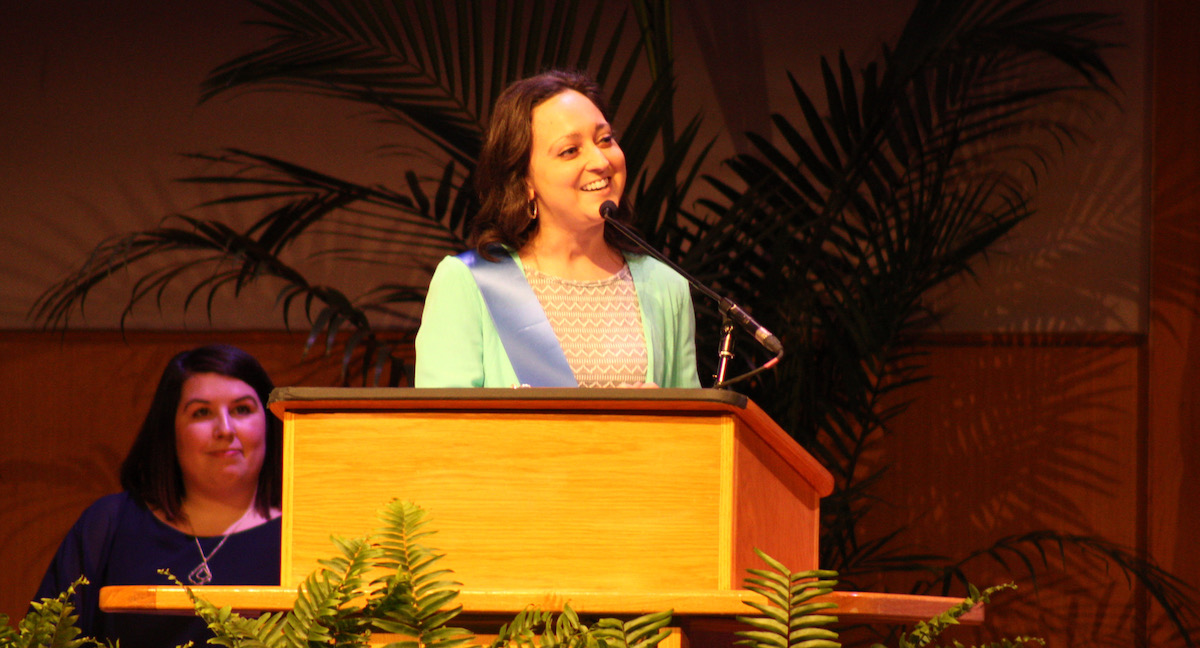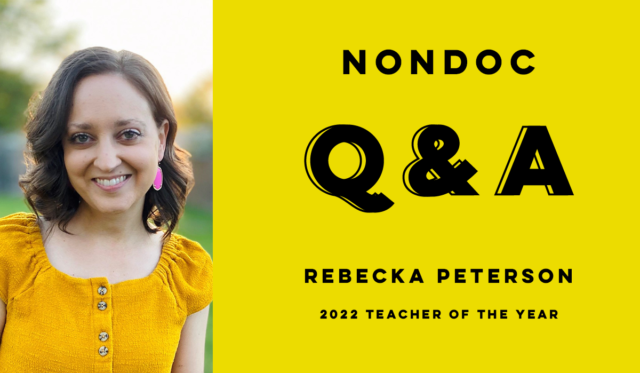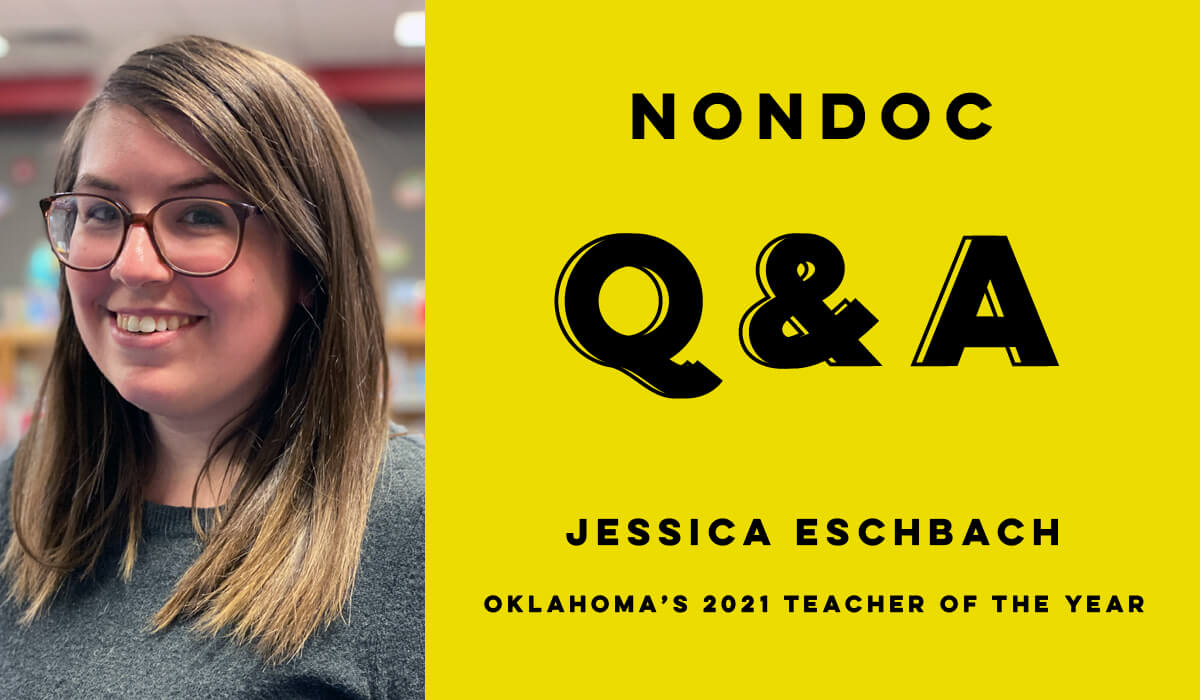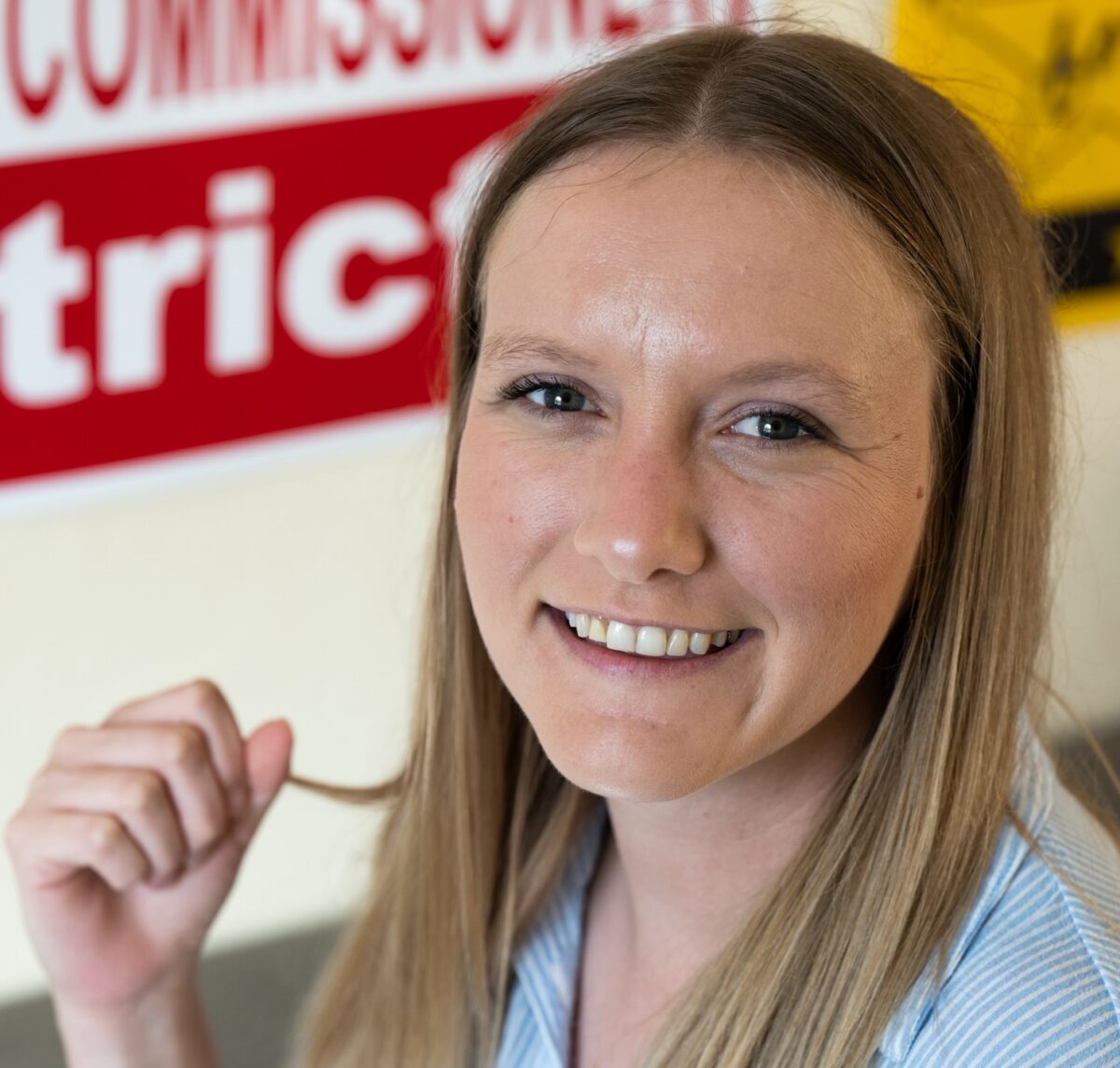Educators and their supporters gathered at the National Cowboy & Western Heritage Museum last week to watch Rebecka Peterson, a math teacher from Union High School, be named the 2022 Oklahoma Teacher of the Year.
“Public education is what’s still right in our society,” Peterson said during the ceremony. “I truly believe that access to free and high-quality education is the bedrock of our democracy.”
Peterson currently teaches pre-calculus, trigonometry and AP calculus and has been with the Union Public Schools District for a decade. She was selected as Teacher of the Year from a pool of 12 finalists from across the state.
On top of her Teacher of the Year designation, Peterson is also a state-level finalist for the Presidential Awards for Excellence in Mathematics and Science Teaching.
RELATED
‘I believe in all of them’: Jessica Eschbach shows kids their potential by Megan Prather
“Rebecka’s success in the classroom can be measured not only through the achievements of her students but through the professional growth of the colleagues she inspires as well,” State Superintendent of Public Instruction Joy Hofmeister said in a press release. “In addition to recruiting and mentoring, she leads through collaboration. Rebecka’s enthusiasm and encouragement have motivated countless other teachers to strive to overcome the challenges of the pandemic and continue providing exemplary instruction to Oklahoma students.”
Peterson will spend next year traveling around the state as a teaching ambassador, urging fellow teachers to stay in the profession and encouraging others to join the field.
In the following Q&A, Peterson discusses her teaching philosophy, how she reaches students who struggle with math and the needs of students and teachers post-pandemic. Responses have been lightly edited for style.

You’ve said that teaching high school was never part of the plan. How did you find yourself in the education profession? How do you view your role as an educator?
I started college with the intention of becoming a mathematics professor. After finishing both my bachelor’s and master’s in mathematics, I decided to accept an instructor position at Tulsa Community College. Part of my assignment was teaching the concurrent college algebra classes at Union High School. I loved teaching those classes. So that summer I became alternatively certified to teach at the high school level and have been there ever since.
I became a math teacher because I loved the idea of instilling confidence in my students through a subject that many find intimidating. My goal was and always will be to add value and dignity to my students. I chose to be a math teacher to impact my students’ lives. What I didn’t know was how much they would impact my life. I am better because of them. I love who I am when I’m with my students. I call them my real-life integral. Just as an integral in calculus accumulates each infinitesimally small piece to create the entire sum, so do my students inch me toward my calling. Piece by piece, they make me into the teacher I hope to be.
During your speech at the Teacher of the Year ceremony, you mentioned that you’re an immigrant to the U.S. How has this life experience affected you as an educator and how do you connect with your students?
By the time I was 16, I had lived in four different countries. While I’m incredibly grateful for my diverse cultural experiences as a child, they often left me feeling a bit untethered. I struggled to know where I belonged, and I compensated by trying to fit in.
These experiences became the pillar of my philosophy on education. I never want my students to feel like they have to perform or try to fit in. I want them to know they belong exactly as they are — no matter their ZIP code, ethnicity, gender or income level. Everyone’s in. Everyone belongs. Everyone has a seat at the table. That is the foundation of democracy, and we as teachers play a critical role in safeguarding that.
How do you approach students who have an “I just can’t do math!” mentality?
I love showing my students the ubiquity of calculus. Calculus is everywhere and harnesses the power of infinity to answer questions that are unsolvable with algebraic techniques alone.
We get to answer interesting questions (or at least interesting to me!) such as: What’s the average value of a Bitcoin over the past year? When will my company start to be profitable? When will the U.S. population hit an inflection point? What time will my body let me sleep if I consume a cup of coffee at 3 p.m.? But, more than that, I want to teach my students how to think like a mathematician.
Our world is so divided. Now, more than ever, we need “math citizens” — citizens who know how to look at data and argue with logic instead of emotion. We need people who can organize their thoughts, pay attention to detail, justify their reasoning and explain their answers. Those are skills you need no matter your career. Those are skills we, as math teachers, have the privilege and responsibility of teaching.
What are your main areas of focus in your classroom two years after the start of the COVID-19 pandemic? What are your students’ greatest needs?
Trauma, particularly when it is unexpected, changes us. Our students lost a quarter of their educational experiences two years ago. Since then, most students have either been virtual and/or have weaved in and out of distance learning. As we are returning to a more stable learning environment, I see that my students’ trust is not where it was years ago, understandably so.
In addition to closing learning gaps, I am also committed to giving my students tools to use when their stress rises, so they can focus and not retreat to “fight or flight” mode. One way we do this in my class is practicing mindfulness — breathing techniques to help our brains stay focused. Our world lauds multitaskers, but the truth is that our brains are incapable of multitasking. Instead, they move back and forth from task to task, depleting our neural resources in the process.
Mindfulness is the opposite of multitasking. It’s the simple exercise of being in the moment by focusing on what we call a “home base.” This helps restore our neural resources, lower our anxiety and increase our tolerance for handling stressful situations.
What do you see as the greatest needs currently facing educators?
Some of our greatest needs are support and encouragement, particularly from administration. I have had principals come sit in my room the entire hour, take thorough notes and then talk me through everything they loved about the hour. I have also had the opposite. One experience makes me want to stay and become even better, the other does not.
Teachers are expected to bring out the best in students, to encourage them, to get to know them. In many ways, teachers need the same from principals. They need to know they are wanted and needed.
Teachers also need time. We need time to plan engaging lessons. We need time to grade. We need time to observe other teachers. We need time to collaborate. We need time to call parents. We need time to breathe.
You’ll be traveling around the state for a year as a teaching ambassador. How do you plan to encourage others to enter or stay in the teaching field?
I believe in the power of storytelling.
I currently write for and help administer a blog called One Good Thing. Our mantra is “every day may not be good, but there’s something good in every day.” We are a group of educators that commit to shining the good in our classrooms. I have purposed to write something every day I have students in my room. To date, I have published over 1,300 good things.
My hope is to take the idea statewide. As I travel, my plan is to start a social media account to showcase the good and important work teachers are doing across this state, one classroom at a time. Think “Humans of New York,” but “Teachers of Oklahoma.”
It feels like we are inundated with opinions these days. Yet, I don’t think opinions change us. Stories change us. Stories soften us. Sometimes, stories even spur us to action. Teachers are the bedrock of education. Their stories need to be told, and I hope I can do just that.
Is there some kind of math secret I could use to win “guess how many jellybeans are in the jar” contests?
You know, I’ve tried to count out the circumference and height of the jar in terms of jelly beans and then apply the formula for the volume of a right circular cylinder … and I still don’t win.
So I think your guess is as good as mine!
























